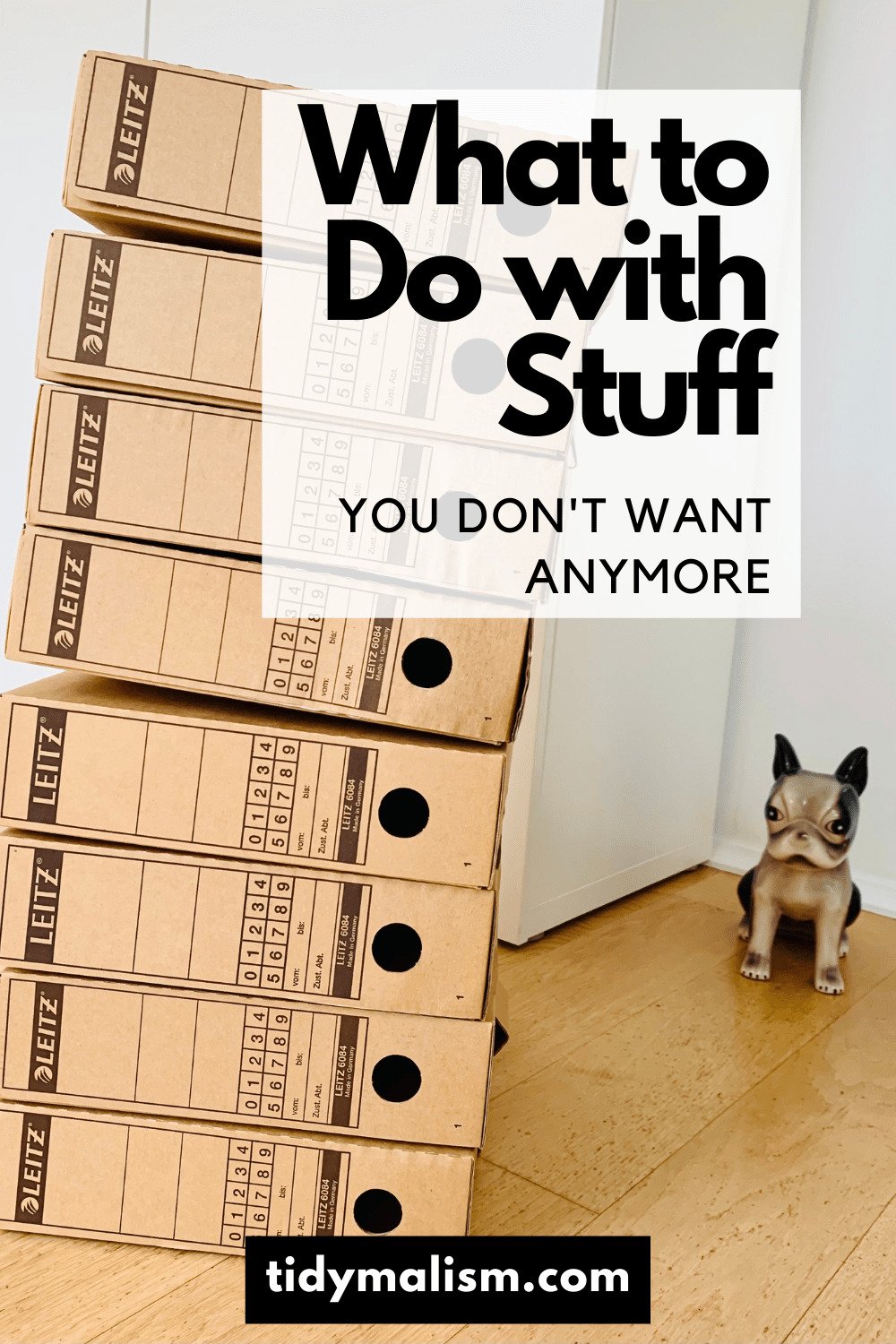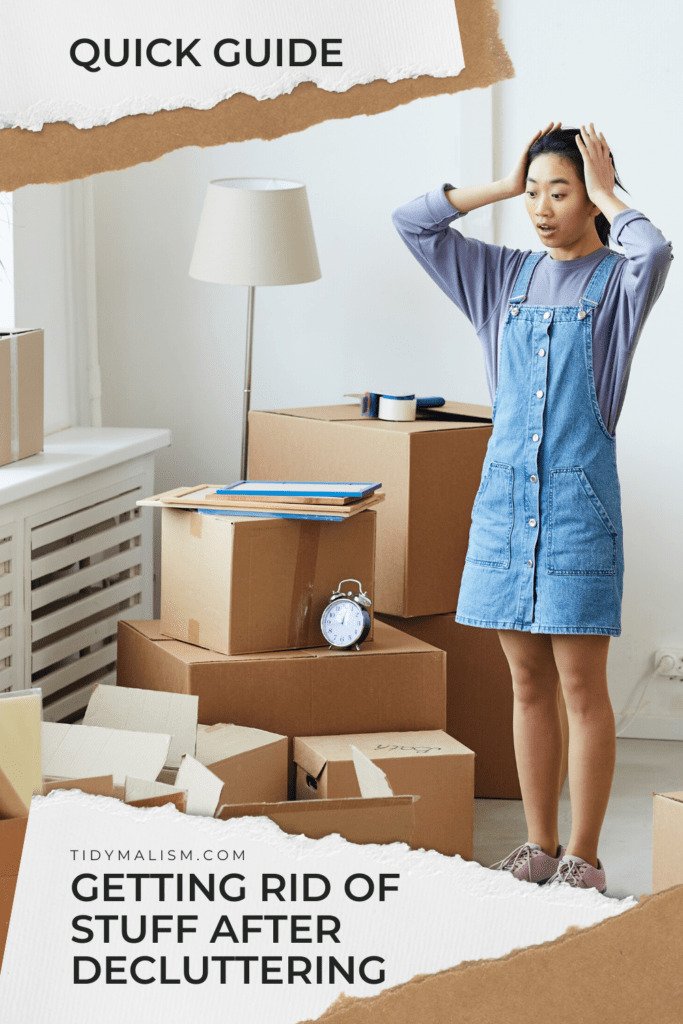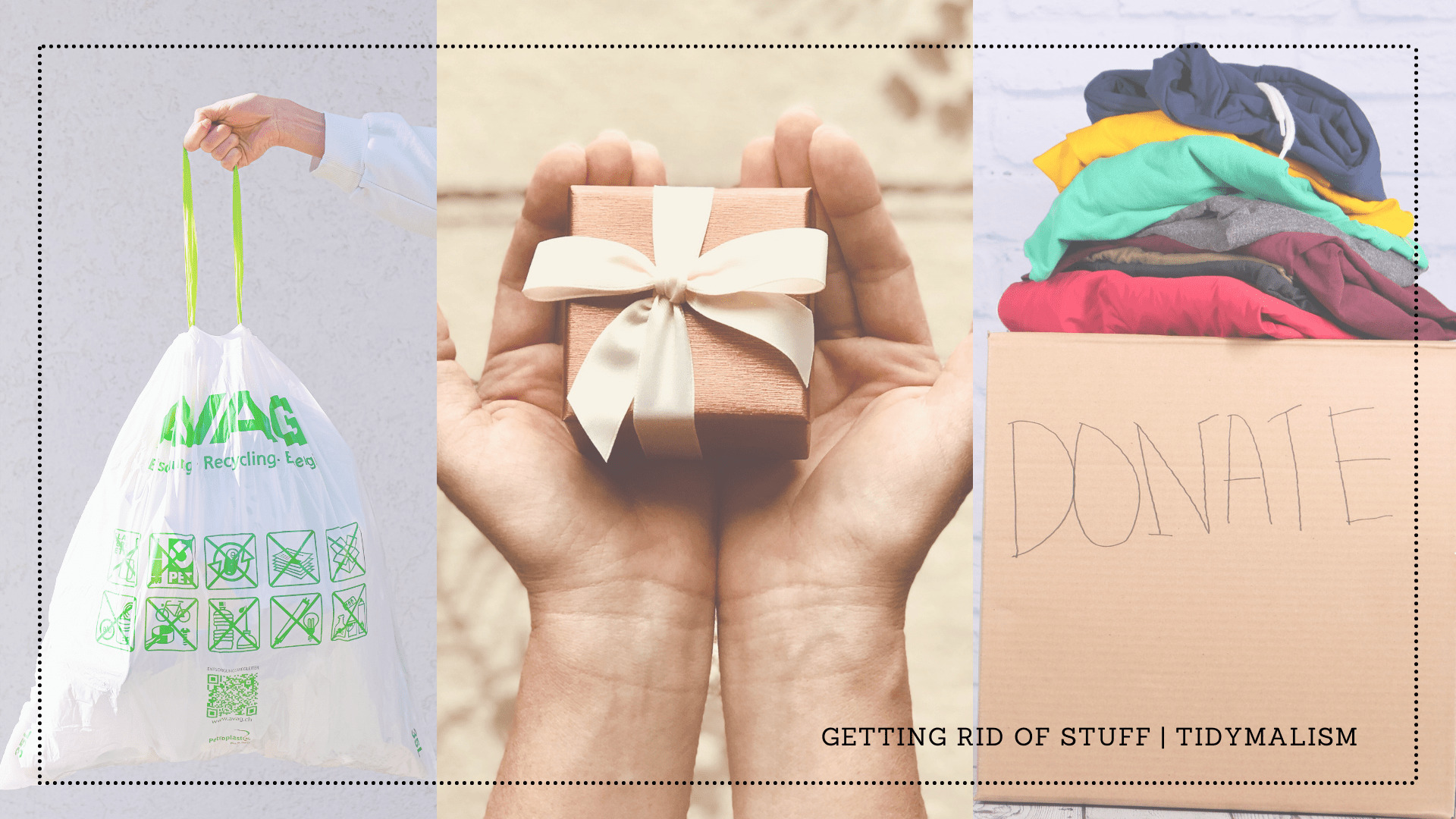So you’ve got your Konmari groove on. Gone on a decluttering frenzy. Played the minimalist game. Or maybe you finally got around to sorting out your cellar, garage or shed. Your space looks great. So clean. Tidy. Instagrammy. You stand there taking it all in, and you smile. Then you turn around and see the mountain of crap you sorted out. Yikes. Now what? How do you get rid of stuff you decluttered?
A great way to get rid of everything you have decluttered is to sort everything into one of three main action categories: discard, gift, or re-sell.
Each of these categories can be broken down into sub-categories like recycling vs. garbage, gifting vs. donating, and online marketplaces vs. trading in. Some other factors should also be taken into consideration when organising this final phase of decluttering and tidying, which I’ll cover here. Let’s dive in and get this decluttered stuff moving!
Table of Contents

Discarding Stuff You’ve Decluttered
All around the world, our landfills are monstrously full. We’ve been consumed by consumerism. Our oceans are brimming with plastic that will never biodegrade. Fast fashion is killing the environment, not to mention the workers who manufacture it.
The less garbage we generate, the better. Ergo: before tossing something to the trash, see first if you can repair or repurpose it. An old chest of drawers might enjoy a second life of purpose in the cellar. Solitary socks with no mate can be used as a dust rag. Old CD-roms make for cool drink coasters. You get the idea.
We could open a discussion here about how saving up to purchase high quality and being a mindful consumer is the more sustainable route to take in life, but that’s not going to help you when you’re knee-deep in that mountain of stuff you just cleared out and need to get out of the way. So the keyword here is responsibility. Let’s be responsible when throwing things out, and dispose of them properly.
Garbage: What Goes Where?
Here in the EU, garbage regulations are very strict in most countries. When separating everyday trash, we differentiate between paper/cardboard, recyclable packaging (plastics and metals), white glass, brown and green glass, biodegradable waste, batteries, and household waste.
These all go into different bins, and batteries need to be taken to a battery bin found at any retail store. Leftover medication must be taken back to a chemist or pharmacy for correct disposal so that it does not wind up in the groundwater.
If you are unsure how to correctly dispose of your household’s waste where you live, check with your municipality or borough if you reside in a single-family home. If you live in a condo or flat, you can ask your building’s custodian or your condo association. They will let you know what goes where, and when collection days are.
Recycling Responsibly
Anything chemical, electronic, or of a larger size will typically need to be taken to your local recycling compound. This might be furniture, electronics, paint thinner, or an old mattress . These things should not be put out on the street, nor should they be left with your building’s waste. It’s likely going to be up to you to recycle them responsibly, and you’ll usually have to cover the cost.
In some places, entire blocks of flats might sometimes join forces with the local recycling centre to arrange for a free common pickup day. If you have that option, definitely take advantage of it! It can save you a trip to the recycling compound, and it will save you money. When re-purchasing larger items like furniture or a TV, it also pays to ask the store if they’ll cart away your old item for free. You can usually negotiate on this, so don’t be too shy to ask your salesperson!
Usually most of what I dispose of at my home winds up in the paper bin (e.g. magazines, old documents), the recyclable packaging bin (e.g. takeaway containers, empty soup cans, plastic packaging), or household waste bin (e.g. old socks or sanitary napkins).
Giving Things Away You Don’t Want Anymore
A lot of the stuff I get rid of gets gifted or donated to charity. Here’s how I handle it all, who gets what, and what you should watch out for when choosing charities to donate to.
Gifting
You probably have a few things you’ve decluttered, which someone you know would enjoy having. Think about the people in your life and see if there’s anything you can set aside for them. During my 2021 decluttering challenge, for example, my housekeeper got first dibs on the clothing items I weeded out. She also took all the little toys and some craft supplies for her granddaughter.
I was a heavy traveller prior to the pandemic, and always brought back loads of stuff. My g-dson likes the freebies I get on my trips and happily snatches up any pochettes I receive on flights. He uses them on his school trips, and as pencil cases. Whenever I have things to gift, I keep them ready in a bag at the front door so I don’t forget to pass them on when I see the person.
Donating Clothing
Other miscellaneous clothing items go to the Red Cross if they are in good condition. I bundle them into parcels and walk them over to a Red Cross drop-off point a few blocks up. If you’re donating clothing, make sure it’s still wearable and clean. Charities generally do not the time or resources to mend or wash anything, and if you donate such items, they will often just wind up in a landfill.
Not All Charities Are Created Equal
Be picky about who you donate to, as well! Some “charities” send clothing to developing countries, which is worse than it sounds, because it can do more harm than good to those local economies. People often think they are donating items when in fact they get re-sold locally for profit, underbidding local merchants. This can be devastating as it inhibits, not aids, development.
Consider also donating good clothing to women’s shelters, crisis centres, refugee immigration facilities if you’re in Europe, or homeless shelters in your vicinity. These places often desperately need nice outfits suitable for job interview situations, for example.
Donating Books, Toys, Electronics & Equipment
There are many options available for donating clean used books, children’s toys, electronic items and hobby equipment. You’ll want to do an online search to see who needs what in your area.
Books
Some libraries, schools, and hospitals take book donations. This is another great option to get rid of stuff. I support a local café bookshop, for example, which is run by and for an integrative organisation for people with disabilities. I’m lucky they’re just a few doors down from me. It’s easy for me to walk my used books over to them whenever I have a new stack ready to let go.
Toys & Electronics
For everything else that’s in good condition, do a search to see who takes what in your area. Children’s hospitals and kindergartens might be interested in toys, for example. Some charities and veteran’s associations appreciate working laptops, MP3 players, and other electronics.
In my particular case, I support a local charity that works with underprivileged children and families in need. They organise extracurricular activities for the kids. It’s a pleasure supporting them, as they’ll come to my house themselves to pick up the items. They even issue official tax vouchers for a small deduction on annual tax returns. I have donated my musical instruments and gear to them, and most recently they picked up a huge lot of photographic equipment I cleared out during my four-week declutter challenge. If you’re sorting out hobby supplies, you might want to see if you have a similar organisation in your area that works with kids and needs supplies.
Selling Items You’ve Cleared Out
Finally, some stuff you declutter might be valuable or coveted, and thus worth re-selling. There’s absolutely nothing wrong with wanting to make some extra cash on the second hand market, and there are so many options available to do so no matter where you live in the world. Below are just a few ideas.
Get Rid of Stuff Via Classified Ads
Regional classifieds like Craigslist or eBay Classifieds are great for selling furniture, smartphones, laptops and so much more. Buyers will come to collect stuff themselves, and things can move very quickly! Usually when I post something to the classifieds in my city, someone comes to pick it up within the space two hours, and they bring cash with them. This is probably the fastest way to get rid of things and make some pocket money.
Do be aware of fraud through classifieds though. I always insist on cash in small bills, and I will only deal with people in my city who can collect the item in person. Don’t accept money orders, cheques, gift cards, or the like. ClassifiedAds has this handy list of how to avoid fraud.
Get Rid of Stuff in Online Marketplaces
eBay is still a thing in many countries (and also a great resource to estimate the value of what you want to sell), but their fees are very high. Before listing your item, you might want to wait for one of their frequent 1$ / 1€ / 1£ weekends where they cap the fees at said low price.
In the APAC region, Carousell, OLX, Kaskus and other secondhand marketplaces are still popular, so if you’re lucky enough to be in Malaysia, Singapore or Indonesia, for example, definitely have a look at your regional platforms.
Get Rid of Apple Stuff Via Trade-In
For Apple electronics specifically, Apple itself has a buy-back or trade-in programme in many countries. In Europe they run it through Likewize. They give you a quote online based on your serial number and information you provide about the item’s condition. Then you ship your item to them and they pay directly to your bank account. If you need suitable packaging to ship your item, they can even send you that beforehand! Search for Apple Likewize online in your country, or have a look at e.g. Likewize in Ireland.
If you’re in the US, Gazelle is a great option for selling or trading in your old smartphones and tablets. Check them out!
Get Rid of Fashion and Luxury Stuff on 2nd Hand Market
Last but not least is the huge online market for second hand and vintage clothing. Vintage (items that are over 20 years old) is hugely on trend in 2021 and will stay so as consumers focus more on sustainability and quality. In the luxury market in particular, there is some serious money to be made with any designer duds you want to get rid of.
There are so many good platforms to get rid of your stuff on. It really depends again on your region and how much you’re willing to pay in seller’s fees. Some of the online marketplaces I personally think are good in the EU, UK and US include Vestiaire Collective, Bagista, Designer Exchange, Freshmans Archive and Fashionphile. Sometimes I also have an article of clothing that’s high-street but very in demand, and I’ve found Vinted is great for that segment.
Be a Good Seller and Know Your Limit
Regardless of what you’re considering selling or on which platform, keep in mind that creating listings and answering buyers’ questions is a LOT of work. You also need to be willing and ready to get your sold items packed up and shipped out right after the buyer makes payment. No one likes waiting around for days (or even weeks in some awful cases) for their parcel to arrive! So if you’re selling on the secondhand market, it’s a good idea to treat your buyers the same way you would want to be treated if you were buying from a private seller.
I personally have my own personal threshold for what the effort of re-sale is worth to me, and for any item I suspect will not fetch a reasonable amount, I prefer to simply donate to charity or give to friends and neighbours.
What about you? How do you get rid of your unwanted things after decluttering? Have you tried any of these options for donating or re-selling? What’s the recycling system like in your country? Leave a comment below!






Leave a Reply